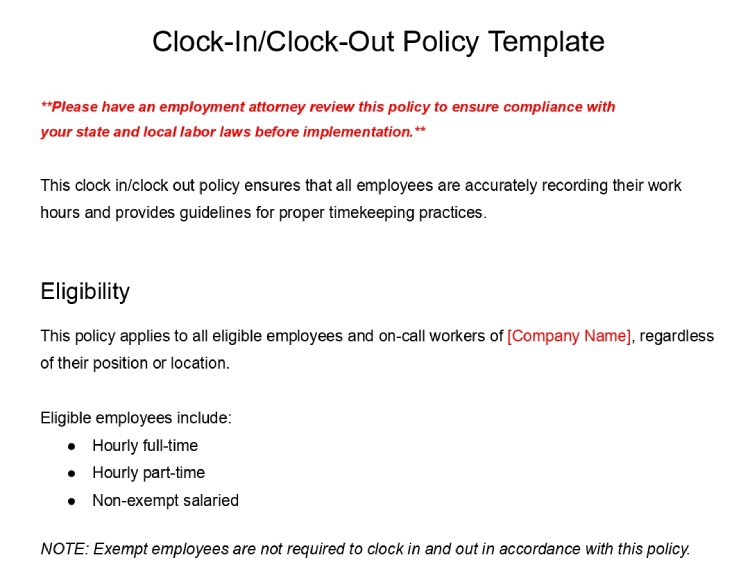A clocking in and out policy sets guidelines for accurately recording employee work hours, ensuring legal compliance, and properly monitoring employee performance and safety. Your clocking in and out policy template should identify eligible employees, explain timekeeping practices, indicate timesheet approvals, mention enforcement and disciplinary actions, and include an acknowledgment section.
Download our free time clock policy template below to create your own time tracking policy.

Thank you for downloading!
If you need help creating a timeclock policy, or need affordable time and attendance options, consider Homebase. It’s free for one location and up to 20 employees.
Step 1: Identify Eligible Employees
While the FLSA has no requirement that your small business record hours in a specific way, it does require that you track the hours worked by certain employees, including the following:
- Hourly full-time and/or part-time
- Nonexempt salaried
- On-call employees
Step 2: Explain Timekeeping Practices
In your policy, clearly explain to employees your expectations of how they clock in and clock out. This includes how and where they will clock in and out, if you round hours, how overtime is calculated, and required breaks.
Step 3: Indicate Timesheet Approvals
Managers or supervisors should verify that the hours recorded on the timesheets match the hours worked by the employee and confirm that any overtime or time-off requests have been properly approved. It helps to avoid errors and potential legal issues down the line.
A good clocking in and out policy should notify employees that they will be required to electronically or physically submit their timesheet to their manager for approval at the end of the workweek or pay period. This will help keep payroll accurate and your overhead costs in check.
Step 4: Mention Enforcement and Disciplinary Actions
Your policy should include information about abuse and dishonesty. Effective employee management often requires disciplinary action when workers abuse a policy—a clock-in/clock-out policy is no exception.
Common violations include the following:
- Buddy punching: This refers to an employee clocking in or out for a coworker who is not present at work. Buddy punching is a common violation and can lead to businesses paying employees for time they did not work.
- Unauthorized overtime: This occurs when an employee continues to work beyond their scheduled shift without prior approval from their supervisor. It can result in employers paying overtime wages not budgeted for, negatively impacting a business’s finances.
- Time theft: This happens when an employee claims they worked hours they didn’t work or when they falsify their timesheet. Time theft can result in the employer paying for the time that the employee did not work, and it can also lead to legal action.
- Neglecting to clock in or out: Employees who neglect to clock in or out can cause inaccuracies in the payroll system, leading to issues with pay and benefits.
For violations of this policy, we suggest sticking with the three-strikes approach—a form of progressive discipline—and making the first offense a minor disciplinary action, followed by a written warning for a second violation. A third violation should be severe and may include termination. This type of behavior is inappropriate and costs your company money.
Step 5: Include an Acknowledgement
The final piece of your clocking in and out policy sample is a section of acknowledgement where employees sign that they have received and reviewed the policy in full. This ensures that every employee understands what is expected of them and the consequences for not adhering to the policy.
The acknowledgement section should include the employee’s name, signature, and the date signed.
Timesheet Recordkeeping Requirements
There is no federal law for clocking in and out, and the FLSA does not mandate that your small business use a time clock. However, you must maintain an accurate record of each employee’s hours worked for hourly and nonexempt salaried workers.
To give you a good idea, here are some of the most important details that you must keep for at least three years for each employee:
- Full name
- Social Security number
- Full birth date, if under age 19
- Job title
- Time and day of the start of the workweek
- Hours worked by day
- Total hours for each workweek
- Type of pay (hourly, weekly, or salary)
- Regular pay rate
- Total weekly regular-time earnings
- Total weekly overtime earnings, if any
- All additions and deductions from employee’s wages
- Total net wages
- Date of payment
- Pay period covered by the payment
A good clock-in/clock-out tool generates reports for you, so you can keep legal records in one place. Homebase, our top-recommended time and attendance software, lets you track employee hours, prep for payroll, remain compliant, and better control your labor costs.
Frequently Asked Questions (FAQs)
Clocking in and out for work ensures that an employee’s time is recorded accurately for payroll purposes. Having a policy in place sets the standard for what is required and the consequences of not properly recording time.
The system used to clock in and out varies depending on your small business needs. You can use simple pen and paper to record time, a spreadsheet, or time tracking software.
A timekeeping policy is a great place to start in helping employees remember to clock in and out. A policy reminds them of the rules, regulations, and consequences.
Bottom Line
Accurately tracking time is crucial for any business type and size to maintain their budget. To achieve this, you must have a clear policy on clocking in and out so that all employees understand how to record their time and what happens if they violate the policy.